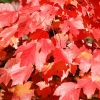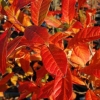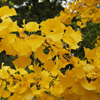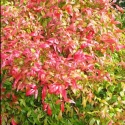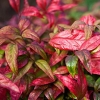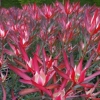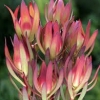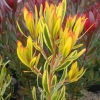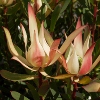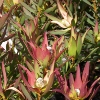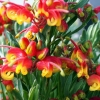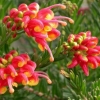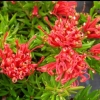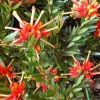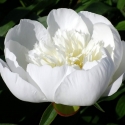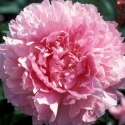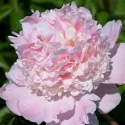Wednesday 24th May, 2017
Winter is a season of colour
Hi
Its been a gusty frosty end to May .... roll on Winter
I so wouldn't be without all of our trees on the southern boundary especially when those amazing wind gusts hit the nursery while we were potting roses last Saturday. They took quite the hammering and even with leaves that were falling you could see that the trees were really filtering or softening the extremes of the wind.
Following the wind we had a ripper frost here in the Waikato, think that we must have hit -3 out here in the country and it sure has made those
leaves age and colour pretty quickly. Then more wind blew
leaves all throughout the nursery. It all actually looks really pretty with coloured
leaves throughout but then its all hands on deck to blow and rake them together then dispose of them. My theory is that if you rake them up often then the job is no longer a huge task. If you leave them they tend to decompose quite quickly into humus which can be harder to clean up especially if its on driveways, but great stuff for the garden.
The other down side to a torrent of leaves is that they can smother ground cover plants and exclude all the light so that the plants suffer. In these situations its important to remove the
leaves so that the plants underneath don't suffocate under a blanket of leaves.
The sudden cold snap sure enhances the colours and adds to the whole colourful picture of this time of year.
Ginkgo are famous for their gorgeous yellow shade and make for quite a handsome conical shaped tree to boot. Maples often have firey red shades and the
Acer rubrum cultivars are spectacular, though this genus of trees is renown for their Autumn shades.
Our dogwoods on the roadside tend to colour into the burgundy red shade and
Nyssa sylvatica never fails to provide awesome autumn colour even if we don't get that frosty weather.
Many other plants also flower at this time of year or provide colour in the form of either bract like flowers like the
leucadendrons or the tubular bell like flowers of the
Ericas. Then there are other shrubs like
Nandina in which the cooler weather turns these hardy evergreens into fiery reds that look spectacular in the garden.
Want a flower that last ages in the vase or just makes for a handsome colourful shrub in the garden then leucos are a great choice. When I say flower well they are really coloured bracts that attract our attention to these handsome plants.
The bracts are best picked as this will keep the shrub in good form in the garden, or if you don't want to pick them then a good cut back when the bracts are going off but before the shrub start to grow will keep these shrubby otherwise leucadendrons can tend to get leggy.
Leucadendrons belong to the Protea family and originally from South Africa requiring a full sun position in the garden and the soil should be free draining and not wet through the winter. Typically the plants in this family are not fond of Phosphates or nitrates that are componets of most fertilsers so don't use these on this group of plants though they will will respond to some liquid organic fertilser types.
Grevilleas Great for winter flowers and they come in a huge range of colour and size as these are great at self hybridisation meaning they aren't fussy which variety crosses with which. Native to Australia, New Guinea, New Caledonia and some Indonesian Islands these popular, evergreen, free flowering plants are found in gardens throughout the world. They flower throughout autumn and winter with many varieties continuing to flower throughout the year. Grevillea benefit from regular pruning. We recommend pruning the plant after flowering has finished and cutting it back by about one third. That is, with a plant that is about 3m tall, cut off about 1m of growth. There is a Grevilliea for ever position in your garden, they range from 10-30cm such as
Gaudichaudii,
Gaudi's Ghost,
Drummer Boy,
Aussie Crawl or
Bronze Rambler, all great groundcovers, mid range shrubs such as
Cream and Green,
Deua Flame,
Gold Rush,
Lady O all at around 1- 1.5m mark right up to small trees such as
Banksii Forsterii or
Dorothy Gordon. Click the links to see our great range that are in stock now.
Strawberry
Camarosa are in stock as bundles of 10, topped and tailed for planting right now. You may well ask what topped and tailed is, that the leaves have been reduced and the roots clipped to stimulate new growth. I always suggest that one cleans the plant by removing the brown and dead material and then you can see quite clearly where to plant to. plant on mounds of rich composted soil where you can use straw on the sides to keep the fruit clean. Plant a heap of these to that you can harvest an abundance of fruit.
While you are planting, then winter is also the time to get that
garlic in the ground. I have my heads aside for planting so will get myself onto it as well. Plant in good rich soil. Break the heads up into single cloves, plant at twice the clove depth and approx 10 cm apart and don't forget to keep some water on them as we head towards summer if it starts to dry out. Too easy...
New 2 Us
Rok solid now this is a New 2 Us product that the package describes as an energised organic fertiliser that is certified organic or just suitable for those that want to know what they are contributing to the soil in their gardens. Its a blended mix of seaweed, fish, sea minerals and highly paramagnetic volcanic rock dust which is full of minerals that should aid your garden. $24.99 per 5kg bag
Tranquilty is a New 2 Us David Austin rose that looks rather pretty from the pics that I have seen creamy or very pale yellows that opens to white with attractive light green foliage.
Don't forget your frost cloths on these cold mornings, they are great protection for those frost tender plants.
Looking forward to this weekend as I always enjoy the cooler days for getting things done. Have a great weekend everyone and happy gardening.
Lloyd, Harry and the Wairere Team
Make it a Wairere weekend where even GNOMES know that gardening's not a drag.
